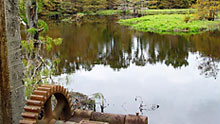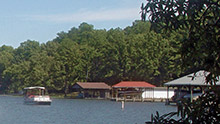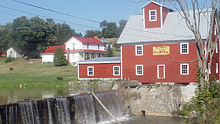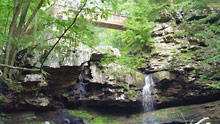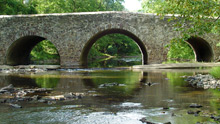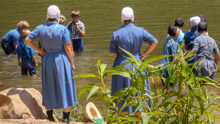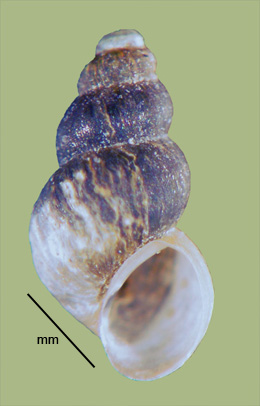> Habitat & Distribution
Fontigens nickliniana ranges from Wisconsin through Indiana, Illinois, and Michigan to western New York and south through Virginia (Jokinen 1992, Hershler et al. 1990), with one extralimital population in central Alabama. In our study area populations are restricted to the Ridge and Valley Province, especially in rich, cold, hardwater springs associated with lush beds of water cress. Those springs drain in every direction, however - east through the Susquehanna, Potomac, and Roanoke to the Atlantic, west through the New River to The Ohio, and south through the Clinch and Holston to The Tennessee.
A broad-brush review of the zoogeography of North American cavesnails has been offered by Hershler & Holsinger (1990), and a more detailed review for the genus Fontigens by Gladstone and colleagues (2021).
Like all members of the genus, F. nickliniana populations reach maximum abundance on solid substrates in springs, spring runs, and caves. Population densities become rapidly attenuated downstream, as though dependent on constant temperature or some other unique aspect of the spring environment. FWGNA incidence rank I-4.
> Ecology & Life History
Fontigens nickliniana has often been called the "water cress snail" (Berry 1943). Populations do not seem to damage the tissues of the cress itself, but rather graze on the epiphytic diatoms and detritus. The restriction of F. nickliniana to limestone-rich regions suggests a requirement for high calcium concentration or some other correlate of water hardness.
We are not aware of any good study on the life history of F. nickliniana. But populations (of all species) typically seem to maintain constant densities year round, as though reproduction might be continuous. Weck (2022) reported approximately one year to maturity (3 mm) in laboratory populations of the cave-dwelling Fontigens antroecetes, constant low levels of reproduction (25 - 80 eggs/pair/yr), and a lengthy hatch time of 70 - 80 days.
> Taxonomy & Systematics
Hershler and colleagues (1990) nominated Fontigens nickliniana as the type of a "nickliniana group," characterized by a tripartite penis with a pair of tubular lobes. Hershler distinguished this three-species group from the four-species group of Fontigens orolibas, bearing a tripartite penis with a tubular distal lobe and a bulbous proximal lobe. The mtDNA sequence study of Liu and colleagues (2021), across 13 populations of 9 Fontigens species, confirmed a genetic distinction between the two Hershler groups.
The 13 populations of Liu and colleagues included samples of F. nickliniana from Bath, Shenandoah, and Washington Counties of Virginia, as well as Indiana and a genbank sequence from Michigan. The Indiana and Michigan COI sequences were indistinguishable from each other, and nested within the sequences from Virginia. For a review of the Liu et al (2021) paper, see my blog post of 9Aug22 from the link below.
Gladstone and colleagues (2021) published a nice shell morphometric study involving samples from nine Fontigens species, including F. nickliniana.
Taylor (1966) suggested that Fontigens comprises a distinct hydrobiid subfamily, the Fontigentinae, which Hershler et al. (1990) synonymized under the Emmericiinae of Brusina (1870). Wilke et al. (2013) did not confirm a close association between Fontigens (represented by a single sample) and the European genus Emmericia, however, tentatively returning the Fontigentinae to subfamilial status. Despite this evidence, self-appointed experts insisted on placing Fontigens in the Emmericiidae for several years (Bouchet et al. 2017), until Gladstone & Whelan (2022) split the genus to its own separate family, the Fontigentidae.
> Maps and Supplementary Resources
- Fontigens distribution in Atlantic drainages (2023)
- Fontigens in drainages of The Ohio (2019)
- Fontigens in drainages of the Tennessee/Cumberland (2022)
> Essays
- A photo comparing living F. nickliniana to Fontigens orolibas is available from my blog post of 26July06 entitled "Springsnails of the Blue Ridge."
- Earlier versions of this website, online until August of 2016, adopted the large, broadly-inclusive concept of the Hydrobiidae (sl) following Kabat & Hershler (1993). More recently the FWGNA project has shifted to the Wilke et al. (2013) classification system, distinguishing a much smaller Hydrobiidae (ss) and elevating many hydrobioid taxa previously ranked as subfamilies to the full family level. For more details, see The Classification of the Hydrobioids.
- See my essay of 6July22 for a fascinating figure of Fontigens nickliniana penis variation originally published by My Buddy Bob in 1990.
- See my essay of 9Aug22, Startled by Fontigens, sort-of, I suppose for a review of the paper by Liu et al. (2021) documenting unusually high levels of intraspecific mtDNA sequence divergence in F. nickliniana. That essay also features photos of topotypic F. nickliniana and the peculiar Virginia spring which they inhabit.
> References
Berry, E. G. (1943) The
Amnicolidae of Michigan: Distribution, ecology, and taxonomy.
Misc. Publ. Mus. Zool. Univ. Mich. 57: 1 - 68.
Bouchet, P., J. Rocroi,
B. Hausdorf, A. Kaim, Y. Kano, A. Nutzel, P. Parkhaev, M. Schrodl, and
E. Strong (2017) Revised classification, nomenclator and
typification of gastropod and monoplacophoran families. Malacologia,
61: 1 526.
Gladstone, N.S., E.
Pieper, S. Keenan, A. Paterson, M. Slay, K. Dooley, A. Engel, and M.
Niemiller (2021)
Discovery of the Blue Ridge springsnail, Fontigens orolibas
Hubricht 1957 (Gastropoda: Emmericiidae) in East Tennessee and its
conservation implications. Freshwater Mollusk Biology and
Conservation 24: 34 - 42.
Gladstone, N. S. and N.
Whelan (2022) Pushing barcodes to their limits:
phylogenetic placeament of Fontigens
Pilsbry, 1933 (Caenogasatropoda: Littorinimorpha: Truncatelloidea) and
elevation of Fontigentidae Taylor, 1966. Journal of Molluscan
Studies 88: eyab038.
Hershler, R. H. &
J. R. Holsinger (1990) Zoogeography of North
American hydrobiid cavesnails. Stygologia 5: 5-16.
Hershler, R., J.R.
Holsinger & L. Hubricht (1990) A revision of the
North American freshwater snail genus Fontigens
(Prosobranchia: Hydrobiidae). Smithsonian Contributions to Zoology
509:1-49.
Jokinen, E.H. (1992)
The
freshwater snails of New York State. New York State Museum Biological
Survey, New York State Museum Bulletin 482.
Kabat, A.R., and R.
Hershler (1993)
The prosobranch snail family Hydrobiidae (Gastropoda: Rissooidea):
review of classification and supraspecific taxa. Smithsonian
Contributions to Zoology 547:1-94.
Liu, H-P., L. Schroeder, A.
Berry, and R. T. Dillon, Jr. (2021) High levels
of mitochondrial DNA sequence divergence among isolated populations of Fontigens
(Truncatelloidea: Emmericiidae) in eastern USA. Journal of
Molluscan Studies 87: eyab026. [pdf]
Stewart, T. W., &
R. T. Dillon, Jr. (2004)
Species composition and geographic distribution of Virginia's
freshwater gastropod fauna: A review using historical
records.
Am. Malac. Bull. 19: 79-91.
Taylor, D.W. (1966) Summary
of North American Blancan nonmarine molluscs. Malacologia
4: 1 - 172.
Weck, R.G. (2022)
Life history observations of the Illinois state
endangered Enigmatic Cavesnail, Fontigens
antroecetes (Hubricht, 1940) made under simulated cave
conditions. Subterranean Biology 43: 185 - 198.
Wilke T., Haase M.,
Hershler R., Liu H-P., Misof
B., Ponder W. (2013)
Pushing short DNA
fragments to the limit: Phylogenetic relationships of hydrobioid
gastropods
(Caenogastropoda: Rissooidea). Molecular
Phylogenetics and Evolution 66: 715 736.

